外研版(2019)选择性必修第四册Unit 6 Space and beyond Period 1 Starting out and understanding ideas 导学案
文档属性
| 名称 | 外研版(2019)选择性必修第四册Unit 6 Space and beyond Period 1 Starting out and understanding ideas 导学案 | 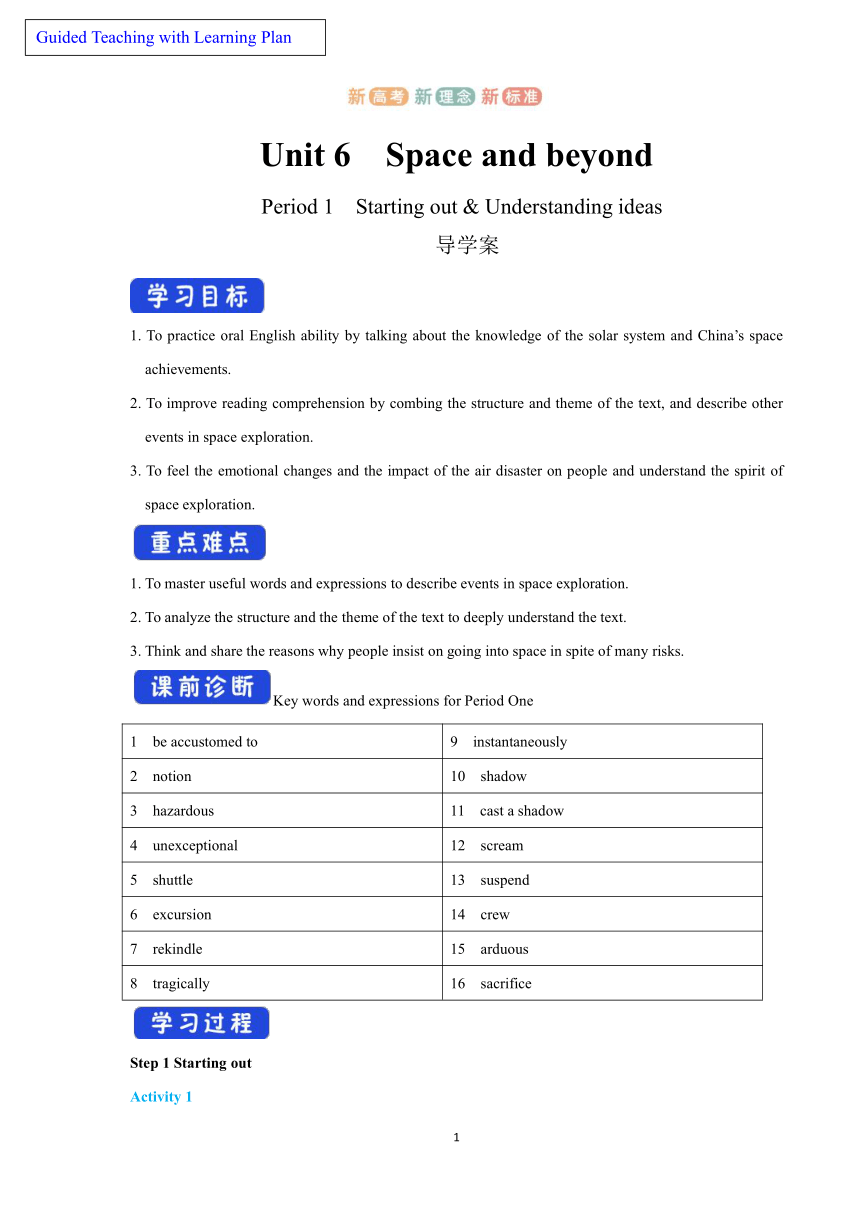 | |
| 格式 | zip | ||
| 文件大小 | 117.2KB | ||
| 资源类型 | 教案 | ||
| 版本资源 | 外研版(2019) | ||
| 科目 | 英语 | ||
| 更新时间 | 2022-08-29 22:28:02 | ||
图片预览

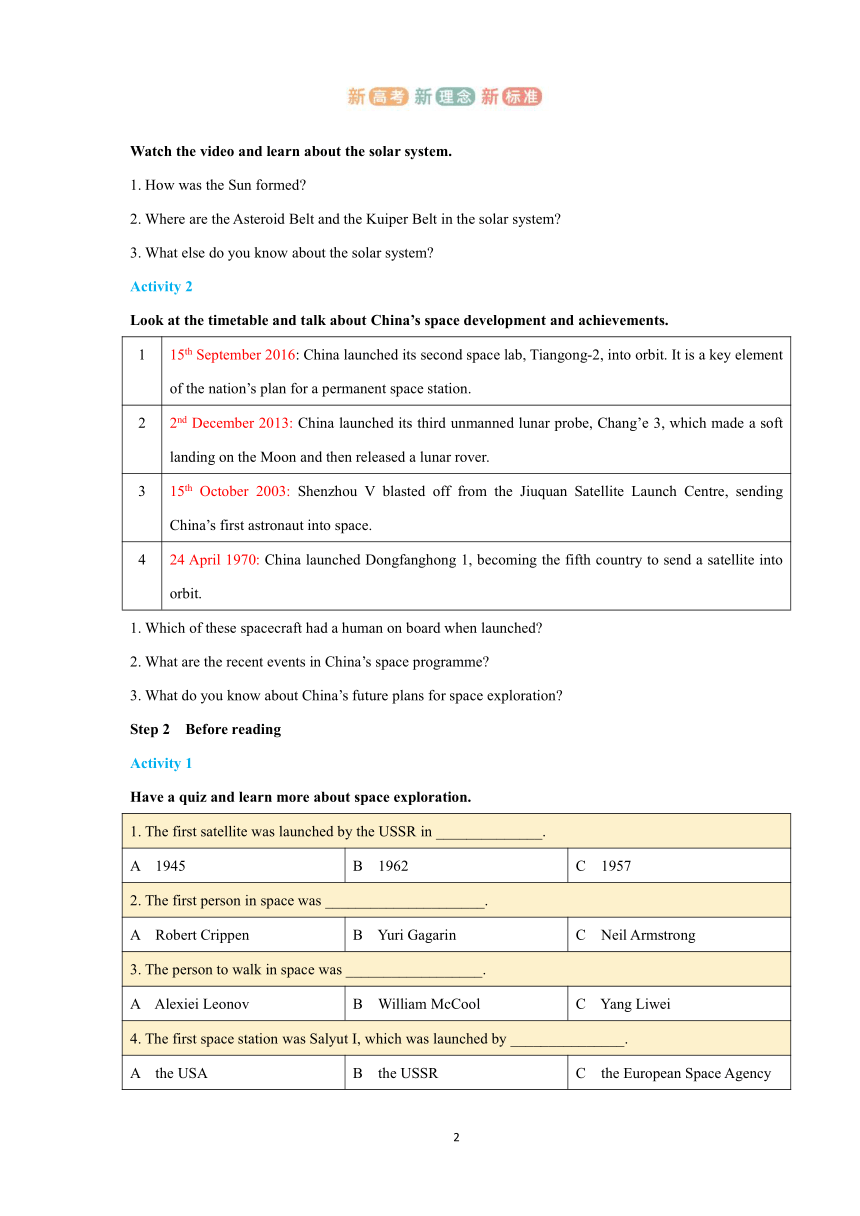
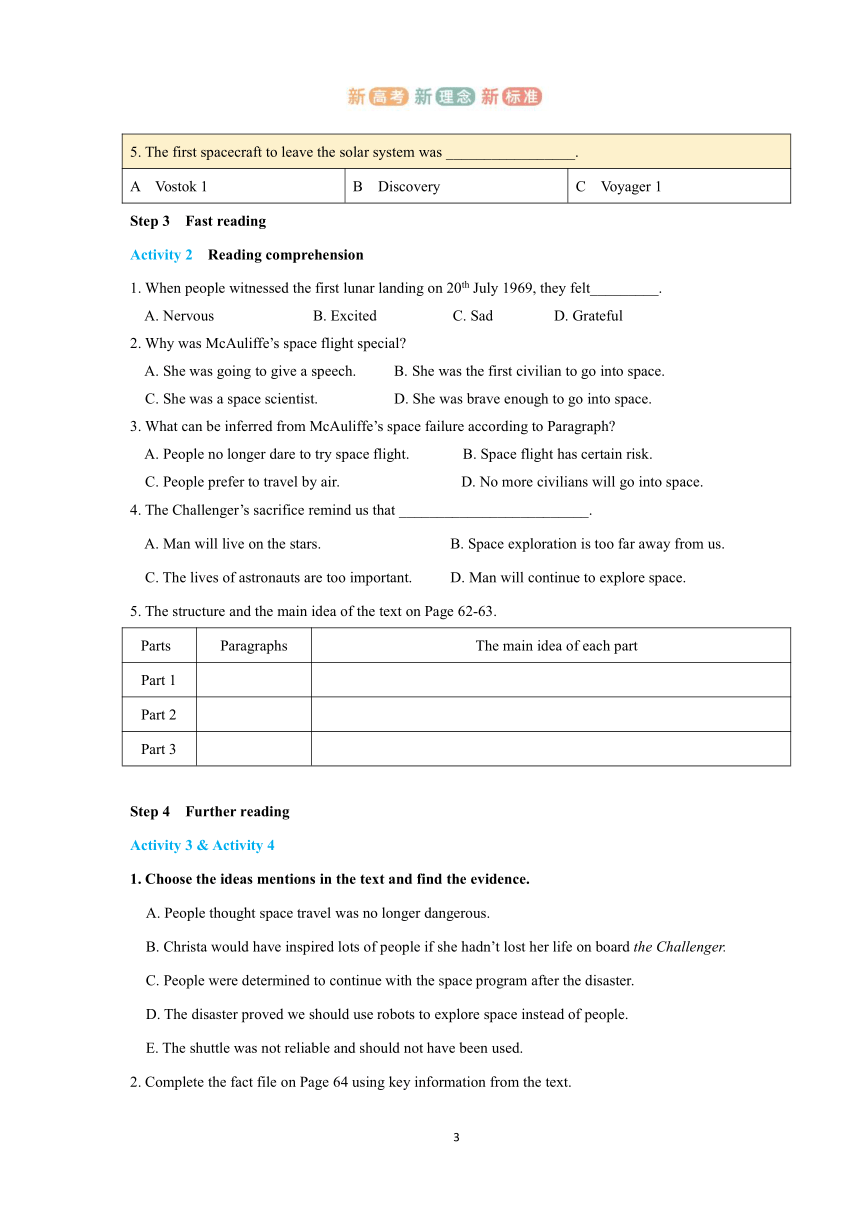
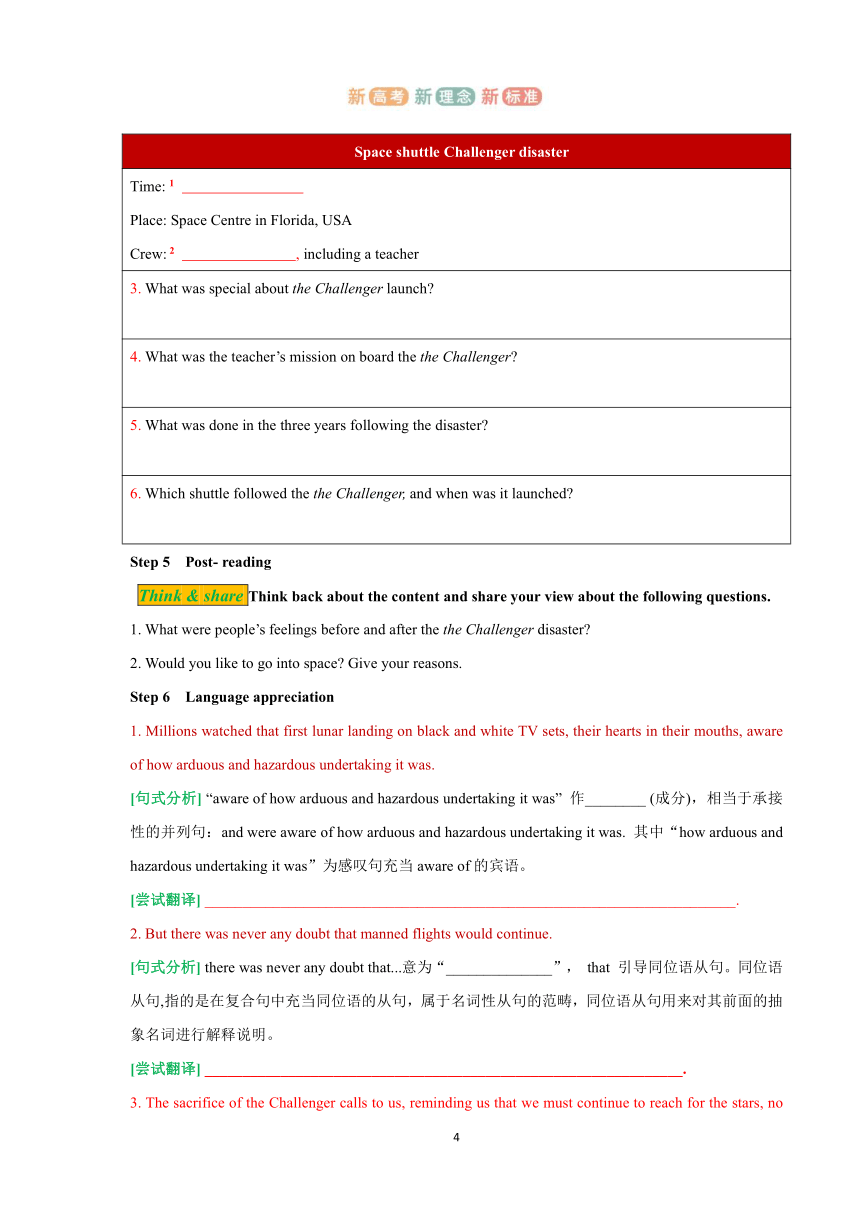
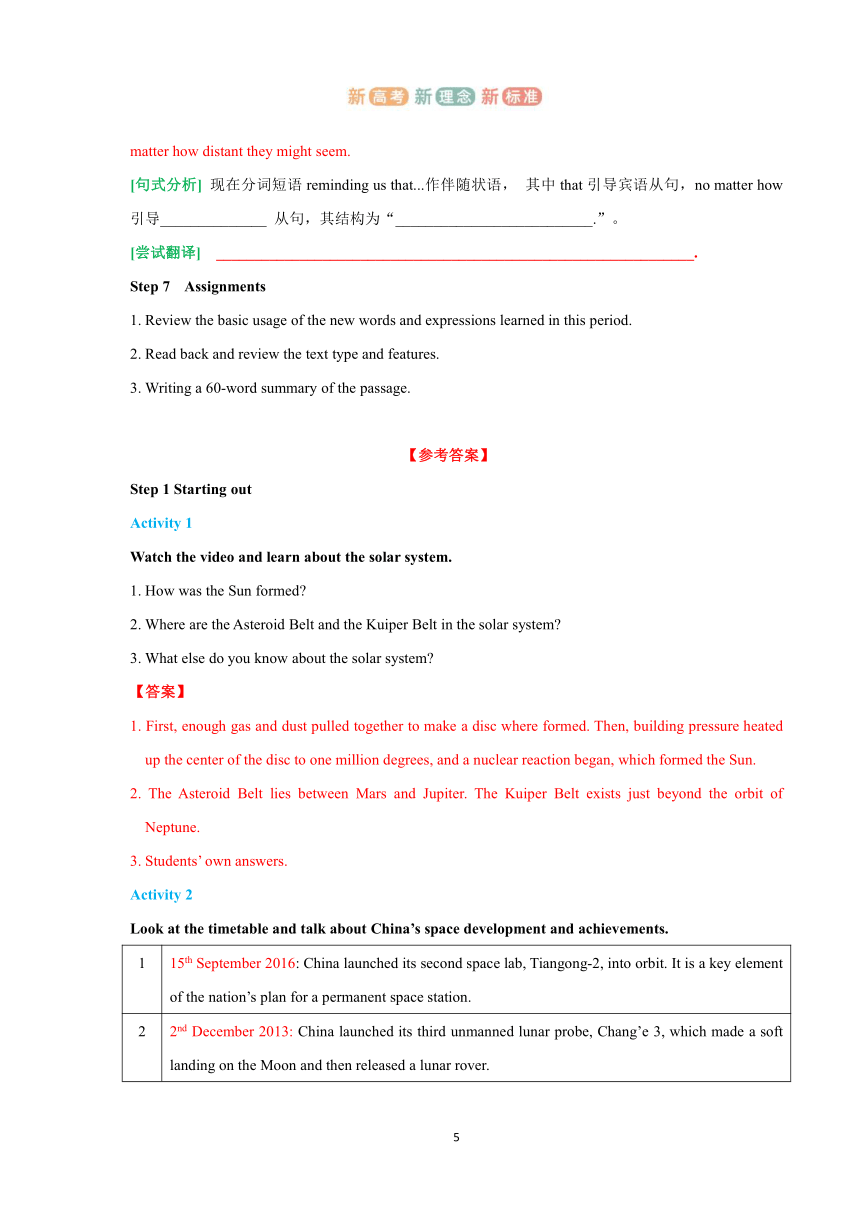
文档简介
Unit 6 Space and beyond
Period 1 Starting out & Understanding ideas
导学案
1. To practice oral English ability by talking about the knowledge of the solar system and China’s space achievements.
2. To improve reading comprehension by combing the structure and theme of the text, and describe other events in space exploration.
3. To feel the emotional changes and the impact of the air disaster on people and understand the spirit of space exploration.
1. To master useful words and expressions to describe events in space exploration.
2. To analyze the structure and the theme of the text to deeply understand the text.
3. Think and share the reasons why people insist on going into space in spite of many risks.
Key words and expressions for Period One
1 be accustomed to 9 instantaneously
2 notion 10 shadow
3 hazardous 11 cast a shadow
4 unexceptional 12 scream
5 shuttle 13 suspend
6 excursion 14 crew
7 rekindle 15 arduous
8 tragically 16 sacrifice
Step 1 Starting out
Activity 1
Watch the video and learn about the solar system.
1. How was the Sun formed
2. Where are the Asteroid Belt and the Kuiper Belt in the solar system
3. What else do you know about the solar system
Activity 2
Look at the timetable and talk about China’s space development and achievements.
1 15th September 2016: China launched its second space lab, Tiangong-2, into orbit. It is a key element of the nation’s plan for a permanent space station.
2 2nd December 2013: China launched its third unmanned lunar probe, Chang’e 3, which made a soft landing on the Moon and then released a lunar rover.
3 15th October 2003: Shenzhou V blasted off from the Jiuquan Satellite Launch Centre, sending China’s first astronaut into space.
4 24 April 1970: China launched Dongfanghong 1, becoming the fifth country to send a satellite into orbit.
1. Which of these spacecraft had a human on board when launched
2. What are the recent events in China’s space programme
3. What do you know about China’s future plans for space exploration
Step 2 Before reading
Activity 1
Have a quiz and learn more about space exploration.
1. The first satellite was launched by the USSR in ______________.
A 1945 B 1962 C 1957
2. The first person in space was _____________________.
A Robert Crippen B Yuri Gagarin C Neil Armstrong
3. The person to walk in space was __________________.
A Alexiei Leonov B William McCool C Yang Liwei
4. The first space station was Salyut Ⅰ, which was launched by _______________.
A the USA B the USSR C the European Space Agency
5. The first spacecraft to leave the solar system was _________________.
A Vostok 1 B Discovery C Voyager 1
Step 3 Fast reading
Activity 2 Reading comprehension
1. When people witnessed the first lunar landing on 20th July 1969, they felt_________.
A. Nervous B. Excited C. Sad D. Grateful
2. Why was McAuliffe’s space flight special
A. She was going to give a speech. B. She was the first civilian to go into space.
C. She was a space scientist. D. She was brave enough to go into space.
3. What can be inferred from McAuliffe’s space failure according to Paragraph
A. People no longer dare to try space flight. B. Space flight has certain risk.
C. People prefer to travel by air. D. No more civilians will go into space.
4. The Challenger’s sacrifice remind us that _________________________.
A. Man will live on the stars. B. Space exploration is too far away from us.
C. The lives of astronauts are too important. D. Man will continue to explore space.
5. The structure and the main idea of the text on Page 62-63.
Parts Paragraphs The main idea of each part
Part 1
Part 2
Part 3
Step 4 Further reading
Activity 3 & Activity 4
1. Choose the ideas mentions in the text and find the evidence.
A. People thought space travel was no longer dangerous.
B. Christa would have inspired lots of people if she hadn’t lost her life on board the Challenger.
C. People were determined to continue with the space program after the disaster.
D. The disaster proved we should use robots to explore space instead of people.
E. The shuttle was not reliable and should not have been used.
2. Complete the fact file on Page 64 using key information from the text.
Space shuttle Challenger disaster
Time: 1 Place: Space Centre in Florida, USA Crew: 2 , including a teacher
3. What was special about the Challenger launch
4. What was the teacher’s mission on board the the Challenger
5. What was done in the three years following the disaster
6. Which shuttle followed the the Challenger, and when was it launched
Step 5 Post- reading
Think & share Think back about the content and share your view about the following questions.
1. What were people’s feelings before and after the the Challenger disaster
2. Would you like to go into space Give your reasons.
Step 6 Language appreciation
1. Millions watched that first lunar landing on black and white TV sets, their hearts in their mouths, aware of how arduous and hazardous undertaking it was.
[句式分析] “aware of how arduous and hazardous undertaking it was” 作________ (成分),相当于承接性的并列句:and were aware of how arduous and hazardous undertaking it was. 其中“how arduous and hazardous undertaking it was”为感叹句充当aware of的宾语。
[尝试翻译] ______________________________________________________________________.
2. But there was never any doubt that manned flights would continue.
[句式分析] there was never any doubt that...意为“______________”, that 引导同位语从句。同位语从句,指的是在复合句中充当同位语的从句,属于名词性从句的范畴,同位语从句用来对其前面的抽象名词进行解释说明。
[尝试翻译] _______________________________________________________________.
3. The sacrifice of the Challenger calls to us, reminding us that we must continue to reach for the stars, no matter how distant they might seem.
[句式分析] 现在分词短语reminding us that...作伴随状语, 其中that引导宾语从句,no matter how引导______________ 从句,其结构为“__________________________.”。
[尝试翻译] _______________________________________________________________.
Step 7 Assignments
1. Review the basic usage of the new words and expressions learned in this period.
2. Read back and review the text type and features.
3. Writing a 60-word summary of the passage.
【参考答案】
Step 1 Starting out
Activity 1
Watch the video and learn about the solar system.
1. How was the Sun formed
2. Where are the Asteroid Belt and the Kuiper Belt in the solar system
3. What else do you know about the solar system
【答案】
1. First, enough gas and dust pulled together to make a disc where formed. Then, building pressure heated up the center of the disc to one million degrees, and a nuclear reaction began, which formed the Sun.
2. The Asteroid Belt lies between Mars and Jupiter. The Kuiper Belt exists just beyond the orbit of Neptune.
3. Students’ own answers.
Activity 2
Look at the timetable and talk about China’s space development and achievements.
1 15th September 2016: China launched its second space lab, Tiangong-2, into orbit. It is a key element of the nation’s plan for a permanent space station.
2 2nd December 2013: China launched its third unmanned lunar probe, Chang’e 3, which made a soft landing on the Moon and then released a lunar rover.
3 15th October 2003: Shenzhou V blasted off from the Jiuquan Satellite Launch Centre, sending China’s first astronaut into space.
4 24 April 1970: China launched Dongfanghong 1, becoming the fifth country to send a satellite into orbit.
1. Which of these spacecraft had a human on board when launched
2. What are the recent events in China’s space programme
3. What do you know about China’s future plans for space exploration
【答案】
1. Shengzhou V.
2. For example, on July 4, 2021, the Shenzhou-12 crew successfully completed all the scheduled tasks during the exit activity, which lasted about seven hours.
3. Students’ own answers.
Step 2 Before reading
Activity 1
Have a quiz and learn more about space exploration.
1. The first satellite was launched by the USSR in ______________.
A 1945 B 1962 C 1957
2. The first person in space was _____________________.
A Robert Crippen B Yuri Gagarin C Neil Armstrong
3. The person to walk in space was __________________.
A Alexiei Leonov B William McCool C Yang Liwei
4. The first space station was Salyut Ⅰ, which was launched by _______________.
A the USA B the USSR C the European Space Agency
5. The first spacecraft to leave the solar system was _________________.
A Vostok 1 B Discovery C Voyager 1
【答案】1--5 CBABC
Step 3 Fast reading
Activity 2 Reading comprehension
1. When people witnessed the first lunar landing on 20th July 1969, they felt_________.
A. Nervous B. Excited C. Sad D. Grateful
2. Why was McAuliffe’s space flight special
A. She was going to give a speech. B. She was the first civilian to go into space.
C. She was a space scientist. D. She was brave enough to go into space.
3. What can be inferred from McAuliffe’s space failure according to Paragraph
A. People no longer dare to try space flight. B. Space flight has certain risk.
C. People prefer to travel by air. D. No more civilians will go into space.
4. The Challenger’s sacrifice remind us that _________________________.
A. Man will live on the stars. B. Space exploration is too far away from us.
C. The lives of astronauts are too important. D. Man will continue to explore space.
【答案】1--4 ABBD
5. The structure and the main idea of the text on Page 62-63. 【答案】
Parts Paragraphs The main idea of each part
Part 1 Paras 1/2 That the Challenger successfully launched had a positive effect on people.
Part 2 Paras 3/4 /5 The disaster of the Challenger cast a shadow on space exploration.
Part 3 Para 6 The space program will continue despite the disaster of the Challenger.
Step 4 Further reading
Activity 3 & Activity 4
1. Choose the ideas mentions in the text and find the evidence.
A. People thought space travel was no longer dangerous.
B. Christa would have inspired lots of people if she hadn’t lost her life on board the Challenger.
C. People were determined to continue with the space program after the disaster.
D. The disaster proved we should use robots to explore space instead of people.
E. The shuttle was not reliable and should not have been used.
【答案】A/B/C
Evidence:
A. Ever Since Nei Armstrong first set foot on the Moon back on 20 July 1969, people have become accustomed to the notion of space travel.
B. ...she might have inspired an entirely new generation of astronauts and space scientists.
C. On 29 September 1988, the space shuttle program resumed with the successful launch of Discovery.
2. Complete the fact file on Page 64 using key information from the text.
Space shuttle Challenger disaster
Time: 1 Place: Space Centre in Florida, USA Crew: 2 , including a teacher
3. What was special about the Challenger launch
4. What was the teacher’s mission on board the the Challenger
5. What was done in the three years following the disaster
6. Which shuttle followed the the Challenger, and when was it launched
【答案】
1 28th January 1986
2 seven astronauts
3 It’s special because Christa aged 37, an ordinary teacher and mother, was about to become the 1st civilian in space.
4 She planned to give two 15-minute lessons from orbit the first to demonstrate the controls of the spacecraft and explain how gravity worked, and the 2nd to describe the objectives of the Challenger program.
5 Space shuttle flights were suspended for nearly three years while the cause of the disaster was investigated, and some of the shuttle’s components were resigned.
6 Discovery followed the Challenger, and was launched on 29 September 1988.
Step 5 Post- reading
Think & share Think back about the content and share your view about the following questions.
1. What were people’s feelings before and after the the Challenger disaster
2. Would you like to go into space Give your reasons.
【答案】
1. Before the disaster people felt optimistic and excited. And after the disaster people felt shocked and terrified. The evidence is that the world went into shock, most people having assumed that this space flight would be no more dangerous than travelling in an aeroplane. Instantaneously, excitement and optimism tuned into terror and failure. It was the most disastrous space accident ever, and it cast a shadow on people’s hearts.
2. In my view, humans are intelligent creatures, and therefore have a natural tendency to explore the unknown. Through the exploration of the universe, we can better understand the universe, understand the evolution of the universe, formation and so on. The evolution of the whole universe is a complete physical book, which is worth exploring and studying by human beings.
Step 6 Language appreciation
1. Millions watched that first lunar landing on black and white TV sets, their hearts in their mouths, aware of how arduous and hazardous undertaking it was.
[句式分析] “aware of how arduous and hazardous undertaking it was”作伴随状语,相当于承接性的并列句:and were aware of how arduous and hazardous undertaking it was. 其中“how arduous and hazardous undertaking it was”为感叹句充当aware of的宾语。
[尝试翻译] 数百万人通过黑白电视观看了第一次月球登陆,他们心惊胆战,意识到这是多么艰巨和危险的任务。
2. But there was never any doubt that manned flights would continue.
[句式分析] there was never any doubt that...意为“毫无疑问......”, that 引导同位语从句。同位语从句,指的是在复合句中充当同位语的从句,属于名词性从句的范畴,同位语从句用来对其前面的抽象名词进行解释说明。
[尝试翻译] 但载人飞行将继续下去,这一点毫无疑问。
3. The sacrifice of the Challenger calls to us, reminding us that we must continue to reach for the stars, no matter how distant they might seem.
[句式分析] 现在分词短语reminding us that...作伴随状语, 其中that引导宾语从句,no matter how引导让步状语从句,其结构为“no matter how + adj+ 主语+谓语+...”。
[尝试翻译] 挑战者号的牺牲召唤着我们,提醒着我们,无论它们看起来多么遥远,我们都必须继续追寻星星。
Period 1 Starting out & Understanding ideas
导学案
1. To practice oral English ability by talking about the knowledge of the solar system and China’s space achievements.
2. To improve reading comprehension by combing the structure and theme of the text, and describe other events in space exploration.
3. To feel the emotional changes and the impact of the air disaster on people and understand the spirit of space exploration.
1. To master useful words and expressions to describe events in space exploration.
2. To analyze the structure and the theme of the text to deeply understand the text.
3. Think and share the reasons why people insist on going into space in spite of many risks.
Key words and expressions for Period One
1 be accustomed to 9 instantaneously
2 notion 10 shadow
3 hazardous 11 cast a shadow
4 unexceptional 12 scream
5 shuttle 13 suspend
6 excursion 14 crew
7 rekindle 15 arduous
8 tragically 16 sacrifice
Step 1 Starting out
Activity 1
Watch the video and learn about the solar system.
1. How was the Sun formed
2. Where are the Asteroid Belt and the Kuiper Belt in the solar system
3. What else do you know about the solar system
Activity 2
Look at the timetable and talk about China’s space development and achievements.
1 15th September 2016: China launched its second space lab, Tiangong-2, into orbit. It is a key element of the nation’s plan for a permanent space station.
2 2nd December 2013: China launched its third unmanned lunar probe, Chang’e 3, which made a soft landing on the Moon and then released a lunar rover.
3 15th October 2003: Shenzhou V blasted off from the Jiuquan Satellite Launch Centre, sending China’s first astronaut into space.
4 24 April 1970: China launched Dongfanghong 1, becoming the fifth country to send a satellite into orbit.
1. Which of these spacecraft had a human on board when launched
2. What are the recent events in China’s space programme
3. What do you know about China’s future plans for space exploration
Step 2 Before reading
Activity 1
Have a quiz and learn more about space exploration.
1. The first satellite was launched by the USSR in ______________.
A 1945 B 1962 C 1957
2. The first person in space was _____________________.
A Robert Crippen B Yuri Gagarin C Neil Armstrong
3. The person to walk in space was __________________.
A Alexiei Leonov B William McCool C Yang Liwei
4. The first space station was Salyut Ⅰ, which was launched by _______________.
A the USA B the USSR C the European Space Agency
5. The first spacecraft to leave the solar system was _________________.
A Vostok 1 B Discovery C Voyager 1
Step 3 Fast reading
Activity 2 Reading comprehension
1. When people witnessed the first lunar landing on 20th July 1969, they felt_________.
A. Nervous B. Excited C. Sad D. Grateful
2. Why was McAuliffe’s space flight special
A. She was going to give a speech. B. She was the first civilian to go into space.
C. She was a space scientist. D. She was brave enough to go into space.
3. What can be inferred from McAuliffe’s space failure according to Paragraph
A. People no longer dare to try space flight. B. Space flight has certain risk.
C. People prefer to travel by air. D. No more civilians will go into space.
4. The Challenger’s sacrifice remind us that _________________________.
A. Man will live on the stars. B. Space exploration is too far away from us.
C. The lives of astronauts are too important. D. Man will continue to explore space.
5. The structure and the main idea of the text on Page 62-63.
Parts Paragraphs The main idea of each part
Part 1
Part 2
Part 3
Step 4 Further reading
Activity 3 & Activity 4
1. Choose the ideas mentions in the text and find the evidence.
A. People thought space travel was no longer dangerous.
B. Christa would have inspired lots of people if she hadn’t lost her life on board the Challenger.
C. People were determined to continue with the space program after the disaster.
D. The disaster proved we should use robots to explore space instead of people.
E. The shuttle was not reliable and should not have been used.
2. Complete the fact file on Page 64 using key information from the text.
Space shuttle Challenger disaster
Time: 1 Place: Space Centre in Florida, USA Crew: 2 , including a teacher
3. What was special about the Challenger launch
4. What was the teacher’s mission on board the the Challenger
5. What was done in the three years following the disaster
6. Which shuttle followed the the Challenger, and when was it launched
Step 5 Post- reading
Think & share Think back about the content and share your view about the following questions.
1. What were people’s feelings before and after the the Challenger disaster
2. Would you like to go into space Give your reasons.
Step 6 Language appreciation
1. Millions watched that first lunar landing on black and white TV sets, their hearts in their mouths, aware of how arduous and hazardous undertaking it was.
[句式分析] “aware of how arduous and hazardous undertaking it was” 作________ (成分),相当于承接性的并列句:and were aware of how arduous and hazardous undertaking it was. 其中“how arduous and hazardous undertaking it was”为感叹句充当aware of的宾语。
[尝试翻译] ______________________________________________________________________.
2. But there was never any doubt that manned flights would continue.
[句式分析] there was never any doubt that...意为“______________”, that 引导同位语从句。同位语从句,指的是在复合句中充当同位语的从句,属于名词性从句的范畴,同位语从句用来对其前面的抽象名词进行解释说明。
[尝试翻译] _______________________________________________________________.
3. The sacrifice of the Challenger calls to us, reminding us that we must continue to reach for the stars, no matter how distant they might seem.
[句式分析] 现在分词短语reminding us that...作伴随状语, 其中that引导宾语从句,no matter how引导______________ 从句,其结构为“__________________________.”。
[尝试翻译] _______________________________________________________________.
Step 7 Assignments
1. Review the basic usage of the new words and expressions learned in this period.
2. Read back and review the text type and features.
3. Writing a 60-word summary of the passage.
【参考答案】
Step 1 Starting out
Activity 1
Watch the video and learn about the solar system.
1. How was the Sun formed
2. Where are the Asteroid Belt and the Kuiper Belt in the solar system
3. What else do you know about the solar system
【答案】
1. First, enough gas and dust pulled together to make a disc where formed. Then, building pressure heated up the center of the disc to one million degrees, and a nuclear reaction began, which formed the Sun.
2. The Asteroid Belt lies between Mars and Jupiter. The Kuiper Belt exists just beyond the orbit of Neptune.
3. Students’ own answers.
Activity 2
Look at the timetable and talk about China’s space development and achievements.
1 15th September 2016: China launched its second space lab, Tiangong-2, into orbit. It is a key element of the nation’s plan for a permanent space station.
2 2nd December 2013: China launched its third unmanned lunar probe, Chang’e 3, which made a soft landing on the Moon and then released a lunar rover.
3 15th October 2003: Shenzhou V blasted off from the Jiuquan Satellite Launch Centre, sending China’s first astronaut into space.
4 24 April 1970: China launched Dongfanghong 1, becoming the fifth country to send a satellite into orbit.
1. Which of these spacecraft had a human on board when launched
2. What are the recent events in China’s space programme
3. What do you know about China’s future plans for space exploration
【答案】
1. Shengzhou V.
2. For example, on July 4, 2021, the Shenzhou-12 crew successfully completed all the scheduled tasks during the exit activity, which lasted about seven hours.
3. Students’ own answers.
Step 2 Before reading
Activity 1
Have a quiz and learn more about space exploration.
1. The first satellite was launched by the USSR in ______________.
A 1945 B 1962 C 1957
2. The first person in space was _____________________.
A Robert Crippen B Yuri Gagarin C Neil Armstrong
3. The person to walk in space was __________________.
A Alexiei Leonov B William McCool C Yang Liwei
4. The first space station was Salyut Ⅰ, which was launched by _______________.
A the USA B the USSR C the European Space Agency
5. The first spacecraft to leave the solar system was _________________.
A Vostok 1 B Discovery C Voyager 1
【答案】1--5 CBABC
Step 3 Fast reading
Activity 2 Reading comprehension
1. When people witnessed the first lunar landing on 20th July 1969, they felt_________.
A. Nervous B. Excited C. Sad D. Grateful
2. Why was McAuliffe’s space flight special
A. She was going to give a speech. B. She was the first civilian to go into space.
C. She was a space scientist. D. She was brave enough to go into space.
3. What can be inferred from McAuliffe’s space failure according to Paragraph
A. People no longer dare to try space flight. B. Space flight has certain risk.
C. People prefer to travel by air. D. No more civilians will go into space.
4. The Challenger’s sacrifice remind us that _________________________.
A. Man will live on the stars. B. Space exploration is too far away from us.
C. The lives of astronauts are too important. D. Man will continue to explore space.
【答案】1--4 ABBD
5. The structure and the main idea of the text on Page 62-63. 【答案】
Parts Paragraphs The main idea of each part
Part 1 Paras 1/2 That the Challenger successfully launched had a positive effect on people.
Part 2 Paras 3/4 /5 The disaster of the Challenger cast a shadow on space exploration.
Part 3 Para 6 The space program will continue despite the disaster of the Challenger.
Step 4 Further reading
Activity 3 & Activity 4
1. Choose the ideas mentions in the text and find the evidence.
A. People thought space travel was no longer dangerous.
B. Christa would have inspired lots of people if she hadn’t lost her life on board the Challenger.
C. People were determined to continue with the space program after the disaster.
D. The disaster proved we should use robots to explore space instead of people.
E. The shuttle was not reliable and should not have been used.
【答案】A/B/C
Evidence:
A. Ever Since Nei Armstrong first set foot on the Moon back on 20 July 1969, people have become accustomed to the notion of space travel.
B. ...she might have inspired an entirely new generation of astronauts and space scientists.
C. On 29 September 1988, the space shuttle program resumed with the successful launch of Discovery.
2. Complete the fact file on Page 64 using key information from the text.
Space shuttle Challenger disaster
Time: 1 Place: Space Centre in Florida, USA Crew: 2 , including a teacher
3. What was special about the Challenger launch
4. What was the teacher’s mission on board the the Challenger
5. What was done in the three years following the disaster
6. Which shuttle followed the the Challenger, and when was it launched
【答案】
1 28th January 1986
2 seven astronauts
3 It’s special because Christa aged 37, an ordinary teacher and mother, was about to become the 1st civilian in space.
4 She planned to give two 15-minute lessons from orbit the first to demonstrate the controls of the spacecraft and explain how gravity worked, and the 2nd to describe the objectives of the Challenger program.
5 Space shuttle flights were suspended for nearly three years while the cause of the disaster was investigated, and some of the shuttle’s components were resigned.
6 Discovery followed the Challenger, and was launched on 29 September 1988.
Step 5 Post- reading
Think & share Think back about the content and share your view about the following questions.
1. What were people’s feelings before and after the the Challenger disaster
2. Would you like to go into space Give your reasons.
【答案】
1. Before the disaster people felt optimistic and excited. And after the disaster people felt shocked and terrified. The evidence is that the world went into shock, most people having assumed that this space flight would be no more dangerous than travelling in an aeroplane. Instantaneously, excitement and optimism tuned into terror and failure. It was the most disastrous space accident ever, and it cast a shadow on people’s hearts.
2. In my view, humans are intelligent creatures, and therefore have a natural tendency to explore the unknown. Through the exploration of the universe, we can better understand the universe, understand the evolution of the universe, formation and so on. The evolution of the whole universe is a complete physical book, which is worth exploring and studying by human beings.
Step 6 Language appreciation
1. Millions watched that first lunar landing on black and white TV sets, their hearts in their mouths, aware of how arduous and hazardous undertaking it was.
[句式分析] “aware of how arduous and hazardous undertaking it was”作伴随状语,相当于承接性的并列句:and were aware of how arduous and hazardous undertaking it was. 其中“how arduous and hazardous undertaking it was”为感叹句充当aware of的宾语。
[尝试翻译] 数百万人通过黑白电视观看了第一次月球登陆,他们心惊胆战,意识到这是多么艰巨和危险的任务。
2. But there was never any doubt that manned flights would continue.
[句式分析] there was never any doubt that...意为“毫无疑问......”, that 引导同位语从句。同位语从句,指的是在复合句中充当同位语的从句,属于名词性从句的范畴,同位语从句用来对其前面的抽象名词进行解释说明。
[尝试翻译] 但载人飞行将继续下去,这一点毫无疑问。
3. The sacrifice of the Challenger calls to us, reminding us that we must continue to reach for the stars, no matter how distant they might seem.
[句式分析] 现在分词短语reminding us that...作伴随状语, 其中that引导宾语从句,no matter how引导让步状语从句,其结构为“no matter how + adj+ 主语+谓语+...”。
[尝试翻译] 挑战者号的牺牲召唤着我们,提醒着我们,无论它们看起来多么遥远,我们都必须继续追寻星星。
